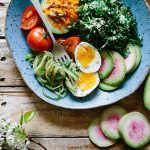Spring has arrived! Have you been eating accordingly? Spring is a time of renovation, birth and regrowth. A great variety of plants are available during this season and you should eat them to your advantage to favour a more radiant skin, immune system and soul.
Spring in the Northern Hemisphere begins the 20th of March and ends on the 19th of June, and with it comes a whole host of foods that are designed by nature to bring you the health benefits your body needs! Among these are sturdier bones, shinier hair, more radiant and moistened skin, stronger immune system and even a more fertile reproductive system.
Due to the increase in light exposure, your body receives a higher dose of vitamin D, which is absorbed through the skin and facilitates the absorption of calcium, leading to stronger bones and teeth. Similarly, an increase in temperature and a more abundant diversity of nutrients can aid you with having healthier skin and hair. Furthermore, according to research, this season is the optimal time for pregnancy so there is an increased probability of becoming pregnant in comparison to the winter. Of course all of these health benefits are boosted with a balanced and seasonal diet.
See Also: YogaLondon Pregnancy Yoga Department
Make sure you don’t go without these foods this spring:
Spring Vegetables
Nature is wise. During this time of year there is a precise change of temperature, humidity and light that favours a great diversity of nutrient-rich vegetables that are perfect for the needs of your body this season. Consuming that which nature provides us with will not only make you feel more in tune with Mother Nature but you will also present you with the appropriate nutrients to increase your energy according to the environment around you.
Some of the fresh produce widely available at this time includes asparagus, radishes and broccoli. To begin with, the word asparagus originates for the Greek, meaning ‘shoot’ or ‘sprout’. These shoots are a great source of fibre, vitamins A, complex B, C, E and K, and the mineral chromium, which helps glucose go into your cells, providing you with energy. There are many ways in which you can cook them from raw to baked in pies or quiches, or simply roasted or steamed. However your prefer them, take into account that a thick spear of asparagus will have higher notes of flavour whilst a younger asparagus will provide you with a fresher taste.
Another spring-time veggie you’ve probably spotted in your supermarket by now includes radishes. These veggies can be a great addition to your salads by increasing the nutrient availability and adding a touch of spiciness. Radishes are rich in some complex B vitamins, fibre, and potassium, as well as copper, magnesium, manganese, and calcium.
Broccoli is a very nutrient dense veggie (usually owing to its dark green colour) that shouldn’t go missing in your shopping list. Rich in vitamin C, and K, , chromium, and folate. It is a very good source of dietary fiber, pantothenic acid, vitamin B6, vitamin E, manganese, phosphorus, choline, vitamin B1, vitamin A (in the form of carotenoids), potassium, and copper. Also part of this season is the purple sprouting broccoli, which are especially good when young and tender. Choose the darker coloured specimens for a higher nutrient content. Eat it raw, steamed, as a side, within soups or even as a snack.
Other veggies that are in season this spring are the Jersey royal new potato, spinach, lettuce, rocket and salad leaves, spring onions, watercress and wild nettles.
Spring Fruits
Rhubarb is one of the colourful stems that is back in the veggie isles. This plant is rich in vitamin K, providing you with more than 45% of the required intake. This is quite helpful since vitamin K is in charge of closing wounds or clotting and protects you from over bleeding, which can even be helpful during the menstrual cycle. Vitamin K also supports healthy bone growth and can limit neuronal damage in the brain, even to the point of Alzheimer’s prevention. Rhubarb is rich in vitamin, B complex and C and it’s a good mineral source of iron, potassium, and phosphorus and manganese.
Another seasonal fruit packed with nutrients is the kiwi. Kiwis are an excellent source of vitamin C, fibre, potassium, magnesium, lutein, folate, zinc and vitamin E. Have them as practical stacks by cutting them in half and eating them with a spoon. This way of eating them will protect the vitamin C from becoming oxidized and will be more practical for you.
Spring Herbarium
Herbs can make a great contribution to your food by adding extra flavours to your pallet by intensifying the sensation of taste which may lead to higher satiety. The herbs to go for this spring are basil, chervil, chives, dill, nasturtium, rosemary, sorrel and tarragon.
Fish & Seafood
There is a time for everything especially when choosing what type of seafood to eat. Fish and seafood that are in a breeding or spawning stage should be avoided. Doing this will protect the sustainability of marine wildlife, which would otherwise devastate our seafood production. During these few months types of fish and seafood that are in season include cod, coley, crab, haddock, langoustine, lobster, plaice, prawns, salmon, sea trout, shrimp, whelks and whitebait. If you would like to know more information about what type of fish and seafood is appropriate to consume throughout the year click here.
Healthy and balanced food options can shape your mood, energy, health and your external glow. Remember to add flavour to your dishes by adding herbs and to increase your satiety. Make use of the abundant availability of fruit and veggies this season to obtain the vitamins, minerals and antioxidants your body needs. Finally, maintain a balance in your meals by adding protein. Whether you choose vegetable or animal sourced-protein make sure your protein source is in season to protect the environment which will in turn protect your health. Seize this spring season to your advantage and include locally and seasonally produced foods for healthier meals.
See Also: A Yogi’s Guide to London: May 2016













